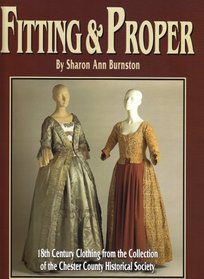Search -
Fitting & Proper
Fitting Proper
Author:
For women, shift, stays, several gowns, petticoats and shortgowns are shown, including one shortgown with matching petticoat, and caps. For men, there are patterns taken from coats, breeches, a lovely shirt with a frill at the neck opening, waistcoat and coat. There are also some less usual items: a calash (women's hood with a collapsible fr... more »
Author:
For women, shift, stays, several gowns, petticoats and shortgowns are shown, including one shortgown with matching petticoat, and caps. For men, there are patterns taken from coats, breeches, a lovely shirt with a frill at the neck opening, waistcoat and coat. There are also some less usual items: a calash (women's hood with a collapsible fr... more »
ISBN-13: 9781880655108
ISBN-10: 1880655101
Publication Date: 3/1/2000
Pages: 122
Rating: ?
ISBN-10: 1880655101
Publication Date: 3/1/2000
Pages: 122
Rating: ?
0 stars, based on 0 rating
Genres:




